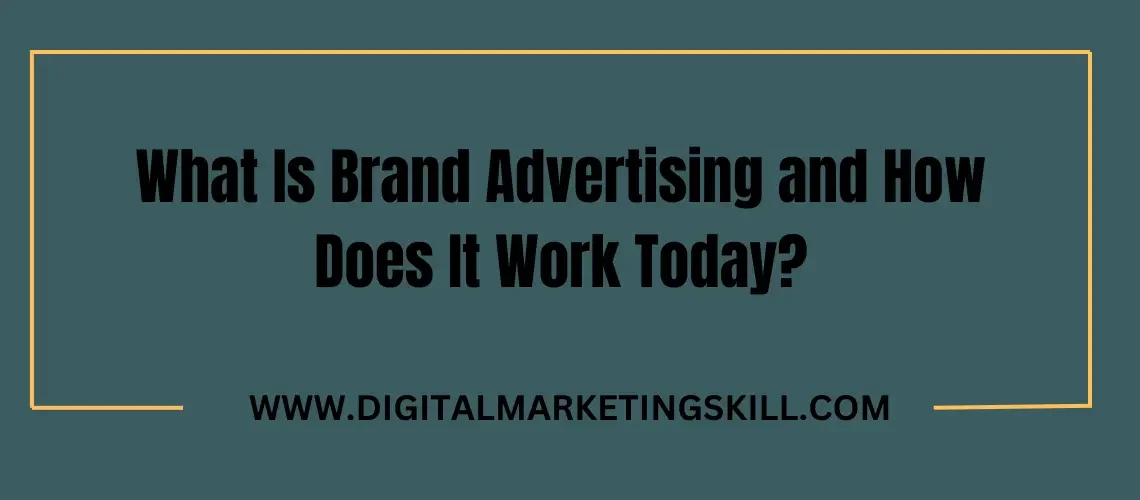As a business owner, brand advertising is an important component of your marketing strategy. Brand advertising is all about creating a lasting impression and building a strong connection with your target audience.
It’s not just about promoting a specific product or service, but rather about establishing your brand’s identity, values, and personality in the minds of consumers.
In marketing today, brand advertising has evolved to reach people across multiple platforms and channels. From eye-catching social media campaigns to engaging video content and influencer collaborations, brands are finding creative ways to capture attention and forge meaningful relationships with their customers.
At its core, effective brand advertising tells a compelling story that resonates with people’s emotions, aspirations, and lifestyles, ultimately turning them into loyal advocates for the brand.
In this article, we will explore the fundamentals of brand advertising and its practical application in reaching and engaging with consumers.
What is Brand Advertising?
Get 50% Discount to Master ALL Aspects of Digital Marketing That Can Earn You $2,500 - $5,000 a month (Even if you are a complete beginner!)
Our students that intentionally implement what they learn from our digital marketing course make back the entire course fee within a single month or more after completing our course because our course gives them many income generating options with unlimited earning potential with no age or location barrier. The best part is no technical skills are required.
An opportunity to change your lifestyle and make money working from anywhere in the world. The results our students get from our digital marketing course prove this could be applied to any market or country and that it is designed for any skill level and work background.
*By signing up, you agree to our privacy policy and terms of service.
Brand advertising is a type of advertising that focuses on building and establishing a brand’s identity, image, and reputation, rather than promoting a specific product or service. Its primary goal is to create an emotional connection with the target audience, increase brand awareness, and foster brand loyalty.
Brand advertising often uses storytelling techniques, imagery, and messaging that resonate with the target audience’s values, interests, and emotions. It can be used in various media channels, including television, print, digital, social media, and outdoor advertising.
The main objective of brand advertising is to create a long-term relationship with the audience, rather than driving immediate sales or conversions. When you build a strong brand, businesses can ultimately drive customer loyalty, advocacy, and revenue growth.
What Does Branding Include?
So far, you understand that brand advertising focuses on creating a powerful brand identity. But what components contribute to a brand identity? It consists of both tangible and intangible elements that collaborate to form a cohesive and easily recognizable image for your business.
Here are the components of a brand identity:
Visual Identity
This is how your brand is presented to the public with a professional touch. It includes your logo, colour scheme, and the overall design style. For example, Digital Marketing Skill Institute has a unique visual identity with our iconic blue and red colours. When you use the same visual style in your marketing, websites, and products, it makes your brand look strong and helps more people recognize it.
Brand Reputation
The reputation of your brand is developed through the trust and credibility you cultivate with your customers over time. Think of it as elements like customer feedback, media exposure, and social validation. Therefore, every point of contact with your brand, from the initial interaction to the post-sale service, plays a crucial role in shaping the overall perception of your brand.
Brand Voice & Tone
Your brand voice is the personality that comes through in your written and spoken communication. It should be authentic, consistent, and in line with your target audience. Think of your brand as a person – how would it communicate? The voice and tone of your brand determine how you connect with your audience.
Airtel Nigeria, a leading telecommunications company, communicates with a friendly and approachable brand voice that connects well with its customers. They often stress the significance of staying connected and empowered in their messaging.
Brand Values
These core principles serve as the foundation for your brand’s actions and decisions. Your brand value should be something beyond your products or services. You must establish a clear set of brand values and a mission statement that enables you to forge emotional connections with your customers. They must be genuine and align with the interests of your target audience.
Benefits of Brand Advertising

Brand advertising provides numerous benefits for businesses aiming to build a solid presence and engage with their target audience. In online marketing, utilizing brand advertising can result in substantial advantages for your brand and they include:
Trust and Credibility
Brand advertising plays a crucial role in establishing trust and credibility with consumers, ultimately leading to long-term success. So, if you consistently create high-quality content and messaging that aligns with your brand values, it can help you build a loyal customer base.
Competitive Advantage
Brand advertising provides a competitive advantage by distinguishing a company from its competitors, creating a unique identity that resonates with customers and sets the brand apart in the market.
Brand Advocacy
Successful brand advertising generates positive word-of-mouth marketing, as happy customers share their brand experiences within their networks. Clients who establish a deeper connection with your brand are more inclined to become advocates. This organic reach is particularly valuable in the digital era, as social media recommendations carry considerable influence.
Increased Brand Awareness
Brand advertising plays a crucial role in enhancing a company’s visibility and expanding its reach to a broader audience. When you use brand advertising, it can elevate your brand’s visibility. So, by strategically using social media advertising, influencer marketing campaigns, or sponsorships on well-known websites, you can greatly increase your brand’s exposure.
Increased Sales and Revenue
Successful brand advertising leads to increased sales and revenue. When a brand is well-known and trusted, customers are more likely to choose it over competitors. A strong brand also allows companies to charge premium prices and enjoy higher profit margins. Investing in brand advertising pays off in the long run through sustained growth in sales and revenue.
Who Should Use Brand Advertising?
Brand advertising is a marketing tool that can bring significant benefits to various businesses and organizations operating in the digital marketing landscape. It is essential to identify the key players that can use brand advertising to maximize its effectiveness.
Here’s a look at who can benefit most from brand advertising:
Startups & New Businesses
Brand advertising is a valuable tool for new businesses and startups in a competitive marketplace. It can be used to establish brand recognition and to set the startup apart from its competitors. It can also be used to lay a solid groundwork for future expansion.
A new business can use it to introduce its services or products to a broader audience, enabling it to garner momentum and establish a strong presence in the industry.
Businesses looking to Broaden their Market Reach
Brand advertising enables businesses to reach a larger audience beyond their current customer base. By strategically utilizing online advertising platforms and influencer marketing campaigns, businesses can introduce their brand to new market segments and expand their reach.
E-commerce Platforms
E-commerce platforms benefit greatly from brand advertising to stand out in the competitive online marketplace. They regularly invest in brand advertising campaigns to highlight their wide range of products and improve customer interaction. Therefore, effective brand advertising helps e-commerce platforms attract and retain customers, drive sales, and differentiate themselves from competitors.
Service-Based Businesses
Service-based businesses can leverage brand advertising to showcase their expertise, build credibility, and establish trust with potential clients. By highlighting their unique value propositions and communicating the benefits of their services, service-based businesses can position themselves as trusted providers in their industry.
Non-profit Organizations
Non-profit organizations can benefit from brand advertising to raise awareness, attract donors, and establish credibility in their cause. By effectively communicating their mission, values, and impact through brand advertising, non-profits can engage supporters, increase donations, and build long-lasting relationships with stakeholders. Investing in brand advertising is crucial for non-profit organizations to effectively reach their goals.
How to Develop an Effective Brand Advertising Strategy
Identify your Target Audience
The key to a successful marketing campaign is knowing your target audience. Who are you trying to reach? What do they need, and want, and how do they behave online? Conducting thorough market research and using audience insights tools provided by social media platforms, such as Facebook Audience Insights, can be very helpful in this stage.
Establish your Brand Identity
After you have a clear understanding of your target audience, it is important to establish a strong brand identity. This includes defining your brand voice, messaging, and visual elements. Consider the overall emotion or impression you want your brand to convey. Do you want to come across as playful and energetic, or more sophisticated and elegant? It is essential to maintain consistency across all your marketing materials, from your website to your social media platforms, to build brand recognition.
Create Engaging Content
To develop an effective brand advertising strategy, focus on creating engaging content that resonates with your target audience. You should prioritize the creation of high-quality content that connects with your target audience and conveys your brand values effectively. This can be achieved through visually striking videos featuring your products, informative blog posts that address customer concerns, or even interactive social media contests.
Monitor and Evaluate Results
Brand advertising is a continuous effort that requires monitoring and analyzing campaign performance. Utilizing website analytics tools and social media insights can provide valuable data on the effectiveness of your campaigns. For example, you may find that your video ads on Instagram are driving high engagement, while your sponsored content on a news website is not performing well. This data will enable you to make informed decisions on how to optimize your advertising strategies.
Platform to use for Brand Advertising
Social Media
Platforms like Facebook, Instagram, Twitter, LinkedIn, and TikTok offer various advertising options, including sponsored posts, Stories ads, and influencer marketing opportunities, allowing brands to reach highly targeted audiences.
Display Advertising
Google Display Network, ad networks like AdRoll and Criteo, and programmatic advertising platforms enable brands to place visually appealing banner ads and rich media ads across millions of websites and apps.
Native Advertising
Platforms like Outbrain, Taboola, and Nativo allow brands to create sponsored content that seamlessly integrates with the surrounding editorial environment, providing a less intrusive advertising experience.
Search Engine Advertising
Google Ads and Bing Ads can be used for brand advertising through search engine marketing (SEM) campaigns, targeting branded keywords and promoting brand awareness.
Out-of-Home (OOH) Advertising
Digital billboards, signages, and other outdoor displays can be leveraged for brand advertising, especially in high-traffic areas or near target audiences.
How to Measure the Success of Your Brand Advertising Campaign

There are various important metrics and approaches that you can employ to assess the success of your brand advertising campaigns.
Brand Awareness
Were you able to effectively increase brand awareness among your target audience through your campaign? Some social media listening tools can be useful to check this. They enable you to monitor mentions of your brand online and assess the general sentiment. For example, if your campaign led to a noticeable rise in positive mentions of your brand on Facebook, this indicates a positive impact on brand awareness.
Website Traffic & Engagement
Has your campaign successfully increased traffic to your website? You can use Google Analytics to monitor website traffic and user interactions. Pay attention to metrics such as website visits, bounce rate, and time spent on site. A notable increase in website traffic and higher engagement levels, measured by time spent on site or page views, suggests your brand advertising strategies are effectively capturing user interest.
Social Media Engagement
Social media is vital for brands in the digital world. Make sure you track important numbers on your social media page to see if your campaign works with your audience. Look at the number of likes, comments, shares, and clicks on links in your posts. More of these means your content connects with people and they find it relevant to engage.
Lead Generation & Sales
Brand advertising typically aims to build long-term brand awareness, but some campaigns may also have specific goals for generating leads or increasing sales. It is important to track relevant metrics based on the objectives of your campaign. For example, if your campaign encouraged people to download an eBook, you would monitor the number of downloads. If the goal was to boost sales using a promotional code, you would track the number of redemptions. An increase in these metrics indicates that your brand advertising efforts are not only boosting brand awareness but also driving desired actions.
Qualitative Feedback
Aside from numerical measurements, it is crucial to collect subjective feedback from your desired demographic to grasp the emotional influence of your brand’s advertising campaign. You can use focus groups, interviews, and social media tracking to gain a deeper understanding of how your audience interprets and reacts to your brand’s messaging.
Brand Advertisement Example
Let’s examine some real-world examples that demonstrate its impact on the Nigerian digital marketing industry. Here are two campaigns that impressed us:
ACCREDITAL: Word of Mouth Marketing
ACCREDITAL offers job opportunities for professionals looking for digital marketing positions by linking them with employers in need of their services. It provides the success stories of students from Digital Marketing Skill Institute who have completed their training and obtained fulfilling positions in the industry. These success stories create brand awareness and generate positive word-of-mouth marketing.
So, what’s next?
Brand advertising is about imprinting your brand identity in the hearts and minds of your target audience, forging a connection that transcends mere transactions. Succeeding in this requires strategic thinking, a commitment to creating high-quality content, and the ability to assess and enhance your approaches as you move forward. The rewards of these efforts are substantial – a loyal customer base, a distinct brand image, and a competitive edge in the highly competitive digital environment.
So, are you prepared to harness the potential of brand advertising for your business? Digital Marketing Skill Institute provides a complimentary digital marketing training program specifically curated to provide you with the expertise and resources necessary to develop a successful brand advertising strategy.
You can learn from various Digital Marketing Institutes. But I recommend Digital Marketing Skill Institute (DMSI) to get started today.
FAQs
What is a brand in advertising?
In advertising, your brand is your reputation. It’s the feeling your target audience gets when they see your logo, hear your name, or interact with your products. It’s more than just a product – it’s a personality, a story, and a connection.
What are the Types of Branding?
There are many branding types. Here are the most common types:
- Product branding: Creating a unique identity for a specific product.
- Corporate branding: Shaping the overall image of your company.
- Personal branding: Building your reputation as an individual.
- Retail branding: Establishing a recognizable identity for your store.
- Service branding: Making your services stand out from the competition.
What is the difference between a brand strategy and a business strategy?
Business strategy focuses on the how – outlining your company’s specific actions to achieve its financial goals. It encompasses things like market research, competitor analysis, and resource allocation. While brand strategy focuses on the why – defining your brand identity, messaging, and values. It’s about creating a unique personality that resonates with your target audience and sets you apart from competitors.
More Posts
What is Data Driven Marketing? Benefits & Challenges
What Is Web Marketing And Why It Is Essential For Businesses
How To Increase Brand Awareness For Your Business In Five Ways





